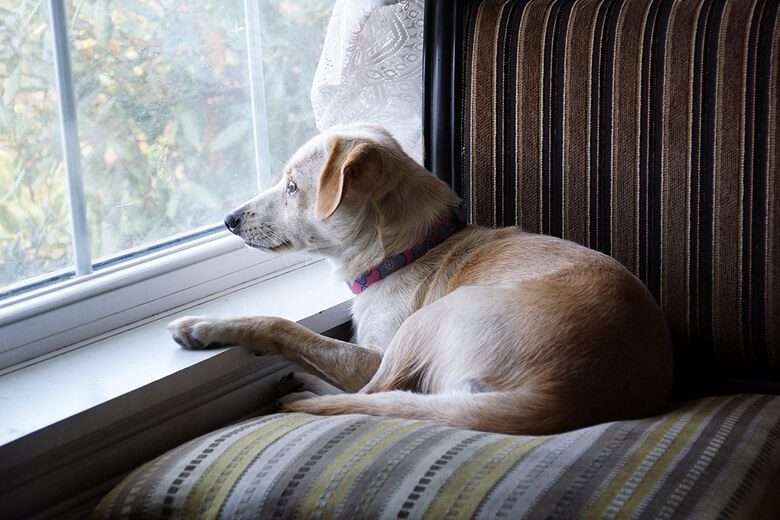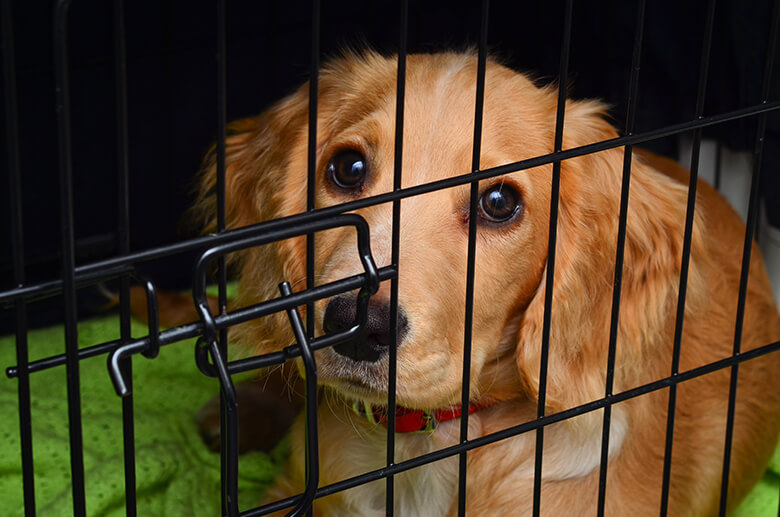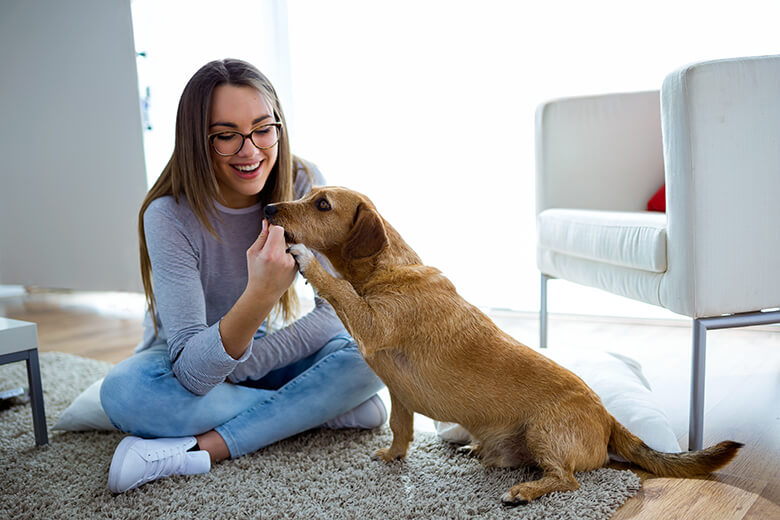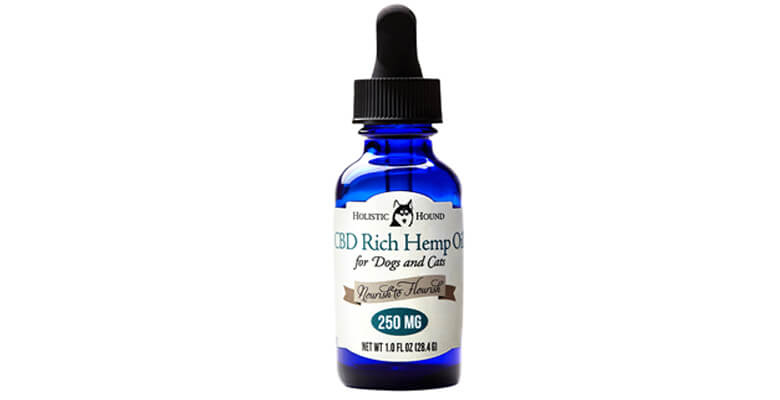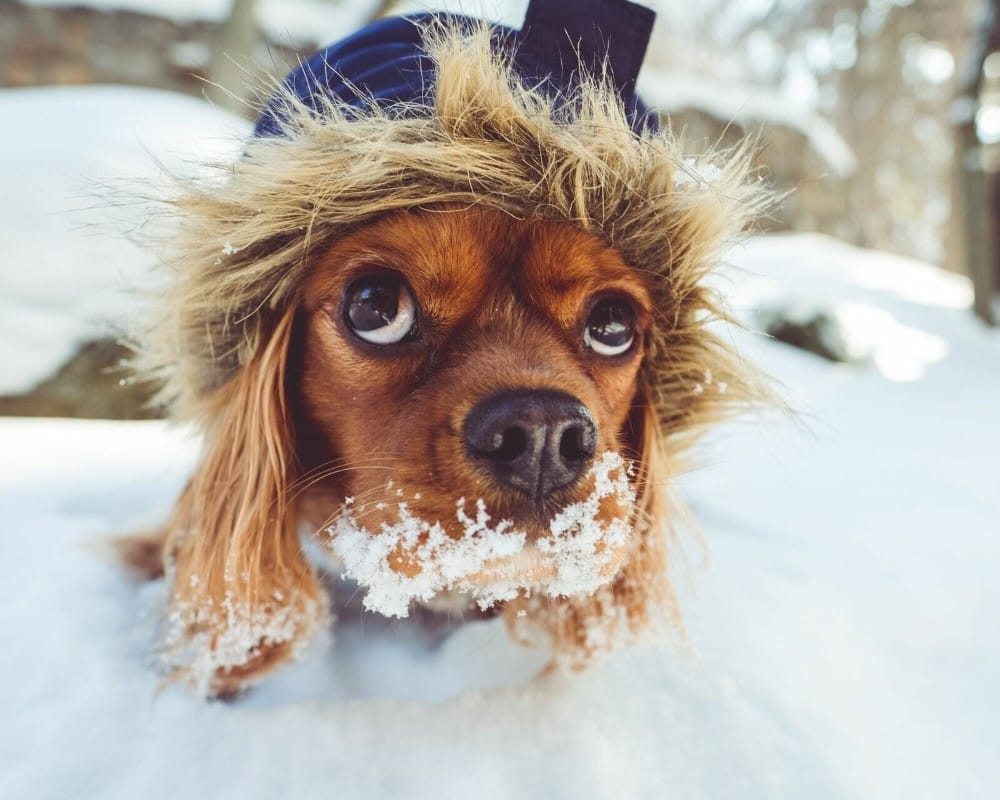It is heartbreaking to watch an anxious dog panting, trembling, drooling or whining, while you stand by without knowing what to do. Some dogs become clingy while others hide under the bed. Our dogs can’t tell us why they’re anxious, which makes it harder to know how to help them. But even if they could talk, would you know what to do?
Dogs don’t get anxious for the same reasons humans do. They don’t worry about paying bills. They don’t care what other dogs think of them. They don’t lose sleep over unfulfilled dreams. Or worry whether that guy (or gal) will call. So, what do dogs get anxious about?
Related: The Secret to Living With an Overly Sensitive Dog
The most common type of anxiety in dogs is separation anxiety, which is anxiety about being alone, usually triggered by their human leaving. Other common anxieties include noise anxiety, often triggered by thunder, fireworks or even noisy trucks; travel anxiety, caused by riding is a car; confinement anxiety, triggered by confined spaces; and Canine Post-Traumatic Stress Disorder, triggered by a trauma such as working in a war zone or being involved in car accident. Extreme anxiety responses to a specific, inexplicable trigger, such as children, hats or glasses, is called a phobia.
Related: A Super Easy Way to Keep Your Dog Calm During the Fourth of July – and Every Day
Dogs suffering from anxiety may have a variety of symptoms. The sooner a dog’s anxiety is diagnosed, the sooner you can begin treatment; the longer the anxiety goes on without intervention, the more extreme the anxiety becomes and the harder it will be to help them
Here are some typical canine anxiety symptoms to help you diagnose your dog.
Symptoms of Canine Anxiety
These are the most common signs. A dog may only exhibit one symptom or suffer from many.
Whining
Moaning
Shivering, shaking or trembling
Posturing with flattened ears and tail between the legs
Hair raised on the back of the neck
Dilated pupils
Cowering and hiding
Whining or whimpering
Excessive drooling
Excessive barking
Excessive energy
Excessive grooming
Panting
Yawning
Licking
Destructive chewing
Pacing
Self harm
Vomiting
Scratching or digging at doors
Howling
Indiscriminate house soiling
Significant destructive behavior
Nervousness
Hypersensitivity
Trembling
Aggression
Dog anxiety is typically diagnosed first by the owner, so keep an eye on your dog and document any unusual behavior. Then bring your dog to the veterinarian to rule out any medical issues. If your dog is completely healthy, ask your vet to recommend a veterinary behaviorist who can diagnose not only the anxiety but the severity, which will guide you in your plan of action.
What NOT to Do If Your Dog Has Anxiety
It’s imperative that you start working with your dog right way. This means you need a good understanding of your options. It’s also important to know what NOT to do.
Don’t punish your dog. The behavior is not a choice, it’s a chemical reaction. Punishing, including yelling, slapping and hitting will make it worse.
Don’t lock your dog in a crate. Even if it saves your couch or your walls from destructive behavior, it will only make your dog’s anxiety worse. Dogs with separation anxiety often have a fear of confined spaces. Dogs with noise anxiety will be traumatized by losing the option to hide from the noise.
Don’t bring another dog into your home with the goal of alleviating separation anxiety. This type of anxiety is often associated specifically with one or more humans. A second dog won’t fix it (though a second dog may provide company for a dog that’s left alone often).
Don’t use a bark collar if your dog barks when anxious. It may stop him from barking, but it will not stop the panic. Often the barking will be replaced by a more destructive symptom.
Related: Want a Canine Einstein? Here are 8 Interactive Toys and Puzzles to Help Improve Your Dog’s IQ
Don’t spend less time with your dog in the hope that he will get used to you being gone. If the anxiety is attached to you, this tactic will make it worse.
It’s also worth noting that dogs should not be left on their own 10 to 12 hours every day without human (and possibly other dogs) interaction. According to Psychology Today, “Dogs are social animals, and they form strong attachments to their humans. … Dogs don’t just tolerate human presence; they actively seek it out. It’s safe to say that companion dogs need social closeness with humans, and deprivation of this contact poses welfare concerns.”
Dogs should never be crated for long periods of time either. It’s physically uncomfortable to be locked in small space for that long, and it’s extremely isolating. “There seems to be a loose consensus among trainers and veterinarians that about four hours is a comfortable range [to crate] an adult dog.” If you’re away from the home longer, arrange for a dog sitter or dog walker, or take your dog to doggie daycare. Other options include taking your dog to work or telecommuting at least a few days a week.
What to Do If Your Dog Has Anxiety
Once you know your dog suffers from anxiety, the first step is to remove the trigger. For dogs with separation anxiety, this means that at first, your dog cannot be left alone. The goal is to eliminate the trigger so that your dog can recover enough to start on a training/behavior modification program and/or medication.
For separation anxiety, you can use doggie daycare, see if a friend who works at home can take the dog during the day or hire a pet sitter. Once your dog is stabilized, you can start on a program of behavior modification. According to Pet Behavior Aid, a behavior modification program is designed to reduce the dog’s anxiety using strategies such as systematic desensitization and counter conditioning.
Related: Now There is a Robot to Entertain Your Dog While You Are Away From Home
“The idea is to gradually expose the dog to progressively longer separations from people, starting with ones so short that the dog doesn’t show any anxiety at all and then make them longer and longer,” Pet Behavior Aid states. “It is important that the dog show no anxiety during the process because an anxiety attack will cause setbacks to the treatment.”
For noise anxiety, try to remove your dog from the location of the noise. If you live in an area with frequent fireworks, take your dog out of the neighborhood during the evening hours when fireworks are scheduled. If your dog reacts to thunder, create a safe place for him to hide; if you can find a room that muffles the sound, like a bathroom, set up a den there.
Gear designed to help dogs with noise anxiety (and other types of anxiety) include the ThunderShirt, the ZenCrate, iCalm Dog System , Enrych Separation Anxiety Relief Dog Pillow and calming treats. For persistent anxiety, CBD oil has had good success. If these don’t do the trick, your veterinarian can prescribe pharmaceutical anti-anxiety medicine.
It’s also important not to pet or coddle your dog when he’s panicked, even though it’s an instinctual reaction. The dog will take this as affirmation that there is really something to be frightened of. Behave normally while the trigger is happening.
And while these are starting points, it is always best to consult with a professional, like a veterinarian or an animal behaviorist, so you (and your dog) have a support system in place.
Related: 15 Reasons Why You Should Consider Giving Your Dog CBD Oil














